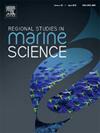Molecular signatures reveal intra-species divergence, undetectable by traditional morphology, in the deadly box jellyfish, Chironex yamaguchii (Cubozoa; Chirodropidae) of Western Pacific
IF 2.1
4区 环境科学与生态学
Q3 ECOLOGY
引用次数: 0
Abstract
Extensive systematics studies have led to remarkable advances in understanding cubozoan diversity, but identifying chirodropid species remains challenging due to morphological similarities and early taxonomic placements of many cubomedusae. Building from this state of knowledge, we investigated the identity of a venomous and deadly chirodropid box jellyfish in the Western Pacific (the Philippines and Japan) by analysing molecular and morphological features of the species. Here, we hypothesised that Chironex yamaguchii occurs in the Coral Triangle region of the Philippines, in addition to the records from the South Kuroshio region in Japan. After thorough morphological and molecular examinations, our findings reveal C. yamaguchii exists in the Coral Triangle. Traditional morphology including the pedalial canals, and microscopy of cnidocytes show nearly identical features between Japan’s and the Philippines’ cubomedusae. Remarkably, molecular analyses using cytochrome oxidase I (cox1) and ribosomal RNA (16S), revealed subtle divergence between Philippine and Japan’s C. yamaguchii (p-distances: cox1=0.04–0.05; 16S=0.03–0.11; patristic distances: cox1= 0.02–0.02; 16S= 1.90–5.20; p-values for both markers and distance values = <0.01). Phylogenetic analyses also confirmed the clade for C. yamaguchii from Japan is distinct from the Philippine clade with moderate to strong branch supports (> 90 %) while haplotype analyses indicated mutations separating Philippine C. yamaguchii from Japan’s specimens and other Chironex species. Further, the genetic markers and morphological identification were inconsistent, with C. yamaguchii from Japan and the Philippines appearing as distinct species in species-delimitation assessments using Assemble Species by Automatic Partitioning and Multi-rate Poisson Tree Processes. With these outcomes, we classified Philippine C. yamaguchii as putative cryptic species, awaiting clarification on possible reproductive isolation of this cubozoan. Our integrative approach resolved the taxonomic uncertainty, and solidified occurrence of C. yamaguchii in the Coral Triangle. This study emphasizes the importance of combined morphological and molecular analyses for accurate species identification in Cubozoa.
求助全文
约1分钟内获得全文
求助全文
来源期刊

Regional Studies in Marine Science
Agricultural and Biological Sciences-Ecology, Evolution, Behavior and Systematics
CiteScore
3.90
自引率
4.80%
发文量
336
审稿时长
69 days
期刊介绍:
REGIONAL STUDIES IN MARINE SCIENCE will publish scientifically sound papers on regional aspects of maritime and marine resources in estuaries, coastal zones, continental shelf, the seas and oceans.
 求助内容:
求助内容: 应助结果提醒方式:
应助结果提醒方式:


